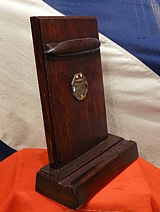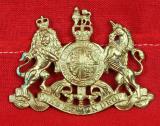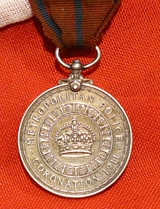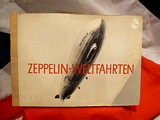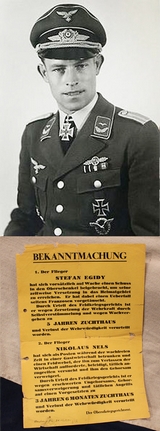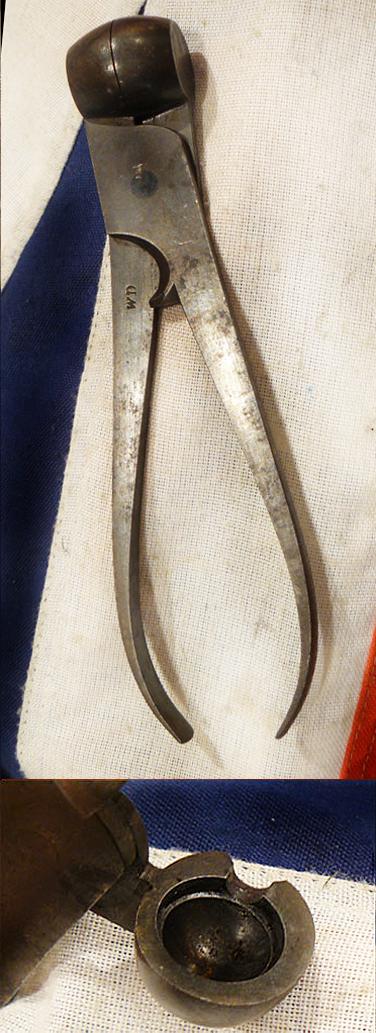An Unusual Piece of Original, Airship Aeronautica, 1929 Zeppelin Display Stand, In Oak With Zeppelin Badge And Carved Airship
Ferdinand von Zeppelin served as an official observer with the Union Army during the American Civil War. During the Peninsular Campaign, he visited the balloon camp of Thaddeus S. C. Lowe. Lowe sent the curious von Zeppelin to another balloon camp where the German-born aeronaut John Steiner could be of more help to the young man. His first ascent in a balloon, made at Saint Paul, Minnesota during this visit, is said to have been the inspiration of his later interest in aeronautics.
Zeppelin's ideas for large dirigibles was first expressed in a diary entry dated 25 March 1874. Inspired by a recent lecture given by Heinrich von Stephan on the subject of "World Postal Services and Air Travel", he outlined the basic principle of his later craft: a large rigidly-framed outer envelope continuing a number of separate gasbags. In 1887 the success of Charles Renard and Arthur Krebs' airship La France prompted him to send a letter to the King of W?rttemberg about the military necessity for dirigibles and the lack of German development in this field. He went on to start the Zeppelin Airship Co. and his name lived on in German legend as the great airship pioneer of international travel and airship warfare. 11 inches x 9 inches x 3.5 inches read more
225.00 GBP
British Royal Crest General Service Helmet Plate in Gilt Brass
The Royal Coat of Arms for the British monarchy. The coat features both the motto of English monarchs, Dieu et mon droit (God and my right), and the motto of the Order of the Garter, Honi soit qui mal y pense (shame upon him who thinks evil of it) on a representation of the Garter behind the shield. It measures 83mm x 64mm read more
95.00 GBP
A Joseph Rodgers & Sons 6 Norfolk St. Sheffield Ltd Bowie Knife
A famous firm of cutlers and silversmiths founded in Sheffield in 1682. It was converted under the style of Joseph Rodgers & Sons Ltd in 1871.
The factory was at 6 Norfolk Street, Sheffield and a showroom at 60 Holborn Viaduct, London.
With Joseph Rodgers GR Crown stamp with the 1891 England mark. on the reverse ricasso is the star and Maltese cross stamp
The star and Malta cross marks was originally that of Benjamin Rich. Rogers registered the same mark in 1764.
Overall used but a very nice example of these famed Bowies from one of the great early Sheffield Bowie makers. Private purchase knives such as this were very popular by British [and American] special forces in WW2 before the FS knife was produced in good numbers in 1941.
No scabbard read more
285.00 GBP
Solid Silver Metropolitan Police Coronation Medal, George Vth 1911
Named to PC Bramble. Very good condition. Original ribbon with silver Spink and Son mount.
The Police Coronation Medal was sanctioned in 1911 as an award to policemen, members of ambulance units, firemen and Royal Parks' staff on duty during the official celebrations of the coronation of King George V that took place during 1911.
The medal is silver and is 1.4 inches (36 mm) in diameter. It was designed by the Australian sculptor Bertram Mackennal.
Obverse: A crowned left-facing bust of King George V with the inscription GEORGIVS V REX ET IND: IMP:.
Reverse: The Imperial Crown with an ornate surround, with the inscription CORONATION 1911 below and the name of the service the recipient was serving with above.
Ribbon: 1.25 inches (32 mm) wide. Red with a narrow central blue stripe, with a similar stripe towards each edge.
The recipient's rank and name were engraved on the edge of the medal read more
60.00 GBP
Napoleonic Wars 10 Bore 'Brown Bess' or Heavy Cavalry Pistol Scissor Mould
This is a most rare piece of Napoleonic Wars infantryman's and heavy dragoon trooper's combat kit, but curiously the second we have had this year which is very unusual. A mould to create bullets for the 10 bore 'Brown Bess' musket and the 10 bore 1796 full bore Heavy Dragoon pistol. A .75 inch mould that creates a .68 inch ball. These military 10 bore 'Brown Bess' ball moulds are now very rare indeed, and a great addition to a collector that owns an original 'Brown Bess' or the 1796 Heavy Dragoon pistol that would want their original Napoleonic Wars scissor ball mould. Slight pitting overall, some were made by William Davies but this one is not maker marked read more
435.00 GBP
Zeppelin-Weltfahrten Picture Card Book
A fascinating piece of German aeronautical history ephemera. rom the first airship in 1899 to the trips of the LZ 127 Graf Zeppelin. 264 black and white images.
The fascination of the zeppelins, the silvery shimmering, sedate floating kings of the sky, has remained unbroken to this day. In the heyday of the Zeppelin era, during the 20s and 30s, the zeppelins opened up almost every continent on earth for well-heeled travelers. This is impressively demonstrated by this book published in 1932, into which extremely interesting photos on the subject of the Zeppelin could be glued.
The book which provides information about the technology and development of the zeppelins ... A picture album made with collectable photographs sold in the 1930's. 24cm x 34cm I card lacking. read more
130.00 GBP
A Very Good Victorian 92nd Gordon Highlanders Silver Cross Belt Badge
92nd Regiment (Gordon) officer's crossbelt badge, silver plated 4 pointed star with St Andrew cross with battle honours, Sphinx below XCII Highlanders, with three threaded screw mounts.
In December 1878, the regiment was ordered to Afghanistan where it was engaged in various security operations following the outbreak of the Second Anglo-Afghan War. In October 1879, it took part in the Battle of Charasiab, where the regiment captured three hills, thereby turning the enemy's flank. Major George White received the Victoria Cross for his part in this action. A further Victoria Cross was won by Lieutenant William Dick-Cunyngham at the Siege of the Sherpur Cantonment on 13 December 1879. At the end of August 1880, the regiment formed part of the force which marched under General Frederick Roberts from Kabul to Kandahar, and at the Battle of Kandahar on 1 September 1880, formed part of the 1st Brigade, which led the advance in sweeping the enemy out of the closely wooded enclosures along the western slopes of the hill on which the village of Gundi Mullah Sahibdad stood.
Instead of returning to the United Kingdom in 1881, the regiment was diverted to Natal to serve in the First Boer War. The regiment participated in the disastrous Battle of Majuba Hill on 27 February 1881. After capturing the hilltop in order to dominate the Boer line, the force of 350 British soldiers of the 58th and 92nd Regiments including a number of Royal Navy gunners, found themselves exposed to heavy and accurate fire early on the following day. This was followed by an assault by 2,000 Boers; despite a desperate last stand, the survivors were swept from the summit. read more
185.00 GBP
Fascinating German WW2 Public Notice Poster Regarding Two Luftwaffe Flyers. Public Crucifixion of Former Luftwaffe Fighting Aces. Blamed For The Loss of The Battleship Tirpitz
Der flieger [flyer] Stefan Egidy hat sich vorsatzlich auf wache einen schuss in den oberschenkel beigebracht, um seine zeitweise versetzung in das helmatgeblet zu erreichen .er hat dabel einen ueberfall seitens franzosen vorgetauscht durch urtell des feldkriegsgerichts ist er wegen zerstzung der wehrkraft durch selbstverstummelung und wegen wachvergehen zu 5 jahren zucthaus und verlust der wehrwurdigkeit verurteilt worden. Roughly it translates that Flyer Stefan Egidy was court martialled for a self inflicted wounding and sentence to 5 years and loss of privileges. Also Flieger [flyer] Niklaus Nels was similar court-martialled and sentenced to 3 years 6 months. German pilots were occasionally court-martialled for all manner of reasons, another one at the time was Born in Oberbalbach, Heinrich Ehrler, he grew up in the Weimar Republic and Third Reich as one of 12 children. He joined the military service in the Wehrmacht in 1935, initially service with the artillery and anti-aircraft artillery. He participated in the Spanish Civil War and following the outbreak of World War II transferred to the Jagdwaffe (fighter force). Following flight training, he was posted to the 4. Staffel of Jagdgeschwader 77 (JG 77?77th Fighter Wing), which was later redesignated to 4. Staffel of Jagdgeschwader 5 (JG 5?5th Fighter Wing).
Scapegoated for the loss of the German battleship Tirpitz, Ehrler - who had been nominated for the Knight's Cross of the Iron Cross with Oak Leaves and Swords prior to the disaster - was court-martialled, stripped of his command and sentenced to three years and two months Festungshaft (honorable imprisonment). Ehrler's sentence was later commuted and his loss of rank rescinded, and in February 1945 he was transferred to Jagdgeschwader 7. According to his fellow pilots, Ehrler thereafter flew in the increasingly desperate air battles without the purpose and dedication that had made him one of the Luftwaffe's most successful aces. On 4 April 1945, he shot down two Allied bombers for his final two victories, before destroying a third by ramming with his damaged aircraft after having run out of ammunition. His last recorded statement was "Theo, I have run out of ammunition. I'm going to ram this one. Good bye. We'll see each other in Valhalla." - Heinrich Ehrler's last transmission over the Squadron Radio Network before he rammed the B-24 bomber "Trouble in Mind," piloted by Captain John Ray, destroying both aircraft and killing himself. Central tear through middle can't be seen in photo
Intriguing ephemera from the 3rd Reich would look very fine if framed, obviously not in good condition but as direct examples of WW2 aeronautical history absolutely fascinating. Remarkable to survive and probably unique examples. read more
135.00 GBP
A Very Good Steel 'Belted Bullet' Mould Marked 14 and WD (William Davies)
A rare collectable for a 19th century 'two-groove' British rifle, such as the Brunswick. Cavity measures .750" at the bottom of the grooves, with approx .70” ball. This mould casts a spherical ball with bands for two-groove rifling. stamped by maker W.D. William Davies who was one of England's best bullet mould makers in the reign of King George in England, and later during the early part of Victoria's reign. This mould is in excellent plus condition.
The rifle with belted ball two-groove rifling that was at the pinnacle of rifle development in the 1830s and 1840s. With multi-groove rifling it was difficult to ram the ball down particularly if the barrel was fouled up and often a hammer had to be carried to belt down the ramrod.
With a belted ball, a belt was created around the bullet and two corresponding deep grooves were cut in the barrel. The ball was carefully located in these grooves and it could be easily pushed down. Since the two-groove rifling was deep cut, there was no possibility of the bullet stripping and quite high charges could be used. Belted ball rifles tended to be in the bigger calibres as they were too tricky to load in smaller calibres.
Overall length 7.5" read more
325.00 GBP
A Most Interesting Late Edo Japanese Gilt Lacquer Wooden Sword and Samurai Artifact Folding Display Stand. Decorated with Hand Painted Cranes and Bamboo
A folding wood and hand painted lacquer sword rack display stand, for the display of three samurai swords and for the area beneath for the decoration of samurai artefacts such as sword fittngs, mempo, abumi, war fans, or, such as beautiful Japanese tea ceremony pieces, early iron water vessels, and tea bowls etc.
See a selection of items shown for illustrative purposes.
Signed by the artist on both the obverse and reverse side. The hand painted cranes and bamboo are on fine gold leaf covered panels, and show considerable age wear, but this enhances its air of contrived antiquity for the display of early samurai swords, weaponry and artefacts
It has long been the tradition of areas of Japanese art to make for display late Edo pieces, in the much earlier ancient forms and styles. Such as, for example, russetted Higo style iron sword mounts. Actually made in the 18th century, but made to appear as they were ancient iron pieces from many centuries before. In many respects as an homage to much revered ancient Japanese art forms read more
1425.00 GBP


